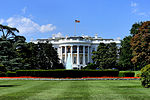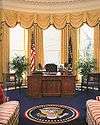Lafayette Square, Washington, D.C.
Lafayette Square is a seven-acre (30,000 m2) public park located within President's Park, Washington, D.C., United States, directly north of the White House on H Street, bounded by Jackson Place on the west, Madison Place on the east and Pennsylvania Avenue on the south. It is named for Gilbert du Motier, Marquis de Lafayette, a French aristocrat and hero of the American Revolutionary War (1775–1783) and includes several statues of revolutionary heroes from Europe, including Lafayette, and at its center a famous statue of early 19th century U.S. President and general Andrew Jackson on horseback with both front hooves raised. The square and the surrounding structures were designated a National Historic Landmark District in 1970.
- For other places named Lafayette Square, see Lafayette Square.
| Lafayette Square | |
|---|---|
 Aerial view of Lafayette Square (foreground) | |
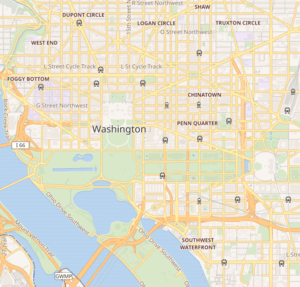 Location within Washington, D.C. | |
| Location | Washington, D.C., U.S. |
| Coordinates | 38°53′58″N 77°02′12″W |
| Area | 7 acres (2.8 ha) |
History
Initial plans
Planned as part of the pleasure grounds surrounding the Executive Mansion, this square was originally part of "President's Park", which is the larger National Park Service unit that also includes the White House grounds, The Ellipse, the Eisenhower Executive Office Building and grounds and the Treasury Building and grounds. In 1804, President Thomas Jefferson had Pennsylvania Avenue cut through that park, separating what would become Lafayette Square from the White House grounds. In 1824, the park was officially renamed in honor of the Marquis de Lafayette, the French general whose involvement was indispensable in securing victory in the American Revolutionary War.[1][2][3]
Named in honor of naval war hero Commodore Steven Decatur,[4] the Decatur House borders Lafayette Square.[5] Using for slave trading,[5] the house remains as one of few surviving examples of an urban slave market.[6]
Early years
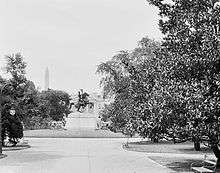
The land on what is now Lafayette Square was formerly used at various times as "a racetrack, a graveyard, a zoo, a slave market, an encampment for soldiers during the War of 1812, and the site of many political protests and celebrations."[6] In the early and mid-19th century, the buildings around the square included the homes of Washington's most prominent residents, including William Wilson Corcoran, Martin van Buren, Henry Clay, Dolley Madison, John Hay, and Henry Adams.[6]
In 1851, Andrew Jackson Downing was commissioned by President Millard Fillmore to landscape Lafayette Square in the picturesque style.[6] On February 27, 1859 Representative Daniel Sickles killed Philip Barton Key II in Lafayette Square. Key had come to the park for an affair with Sickles' wife, only to be discovered and killed by the congressman.[7]
20th century
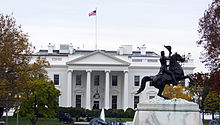
In the 20th century, the area around the square became less residential, with buildings increasingly occupied by offices and professional groups,[6] especially in the 1920s.[8] The last resident, Mary Chase Morris of the O'Toole House (730 Jackson Place), died during the Great Depression era, and her former home became an office building.[6]
Today's plan for the park dates from the 1930s. The park has five large statues. In the center stands Clark Mills' equestrian statue of President Andrew Jackson, erected in 1853; it is the first bronze statue cast in the United States.[9] In the four corners are statues of foreign Revolutionary War heroes:[6]
- Major General Marquis Gilbert de Lafayette (depicting the Marquis de Lafayette, of France, by sculptors Alexandre Falguière and Antonin Mercié, installed 1891);[10]
- Major General Comte Jean de Rochambeau (depicting the comte de Rochambeau, of France, by sculptor Fernand Hamar, dedicated 1902);[11]
- Brigadier General Thaddeus Kosciuszko (depicting Tadeusz Kościuszko, of Poland, by sculptor Antoni Popiel, dedicated 1910);[12] and
- Major General Friedrich Wilhelm von Steuben (depicting the Baron von Stueben, of Prussia, by sculptor Albert Jaegers, dedicated 1910).[13]
Lafayette Square was a popular cruising spot for gay men until the 1950s Lavender scare.[14]
In the 1970s, Lafayette Square was overrun with a large population of Eastern gray squirrels—possibly "the highest density of squirrels ever recorded in scientific literature"—resulting in the squirrels' destruction of many trees and flowers in the park.[15] The squirrels' large numbers were sustained because the public overfed the squirrels, and because nest boxes had been installed at some point and had been maintained by the National Park Service.[15] In 1985 and 1987, the squirrel overpopulation issue was solved through a project in which the nest boxes were removed, and many squirrels were captured and relocated away from Lafayette Square (to Fort Dupont Park and elsewhere).[15]
In 1989, Drug Enforcement Administration agents arranged a crack cocaine purchase in Lafayette Park prior to President George H. W. Bush's delivery of a national address that was part of his ongoing effort against drug abuse.[16]
Thomas and Concepcion Picciotto are founders of the White House Peace Vigil, the longest running anti-nuclear peace vigil in the history of the United States, at Lafayette Square.[17]
June 2020 protests
On June 1, 2020, during mass protests in Washington, D.C. following the killing of George Floyd in Minneapolis, Lafayette Square was forcefully cleared of peaceful protesters and clergy by security forces on the orders of U.S. Attorney General William Barr during the Trump administration. Barr ordered the controversial clearing of the square so that President Donald Trump could walk from the White House and across the street to St. John's church for a photo op.[18]
References
- "Lafayette Square Historic District. May 1, 1802". National Park Service. p. 175.
- "Foundation Document: The White House and President's Park" (PDF). National Park Service. Retrieved 2 December 2017.
- "Reservation List: The Parks of the National Park System, Washington, DC" (PDF). www.nps.gov. National Park Service; Land Resources Program Center; National Capital Region. Retrieved 25 November 2017.
- "The Historic Decatur House". White House Historical Association.
- DeNeen L. Brown, A history lesson for Trump: Lafayette Square was once bordered by 'slave pens', Washington Post (June 5, 2020).
- "Lafayette Square, Washington, DC". General Services Administration.
- Marlowe, Beth (May 15, 2015). "A few bad days in Washington, D.C., history". Washington Post.
- Sixteenth Street Architecture (Vol. 1), Commission of Fine Arts, 1978, pp. 1-7.
- Kames M. Goode. "Four Salutes to the Nation: The Equestrian Statues of General Andrew Jackson". White House Historical Association.
- "Major General Marquis Gilbert de Lafayette, (sculpture)". Inventory of American Sculpture, Smithsonian Institution Research Information System. Smithsonian American Art Museum. IAS DC000217.
- "Major General Comte Jean de Rochambeau, (sculpture)". Inventory of American Sculpture, Smithsonian Institution Research Information System. Smithsonian American Art Museum. IAS DC000072.
- "Brigadier General Thaddeus Kosciuszko, (sculpture)". Inventory of American Sculpture, Smithsonian Institution Research Information System. Smithsonian American Art Museum. IAS DC000215.
- "Major General Friedrich Wilhelm von Steuben, (sculpture)". Inventory of American Sculpture, Smithsonian Institution Research Information System. Smithsonian American Art Museum. IAS DC000216.
- "Telling All Americans' Stories: LGBTQ Heritage Introduction". National Park Service.
- John Kelly, Remembering the Great Squirrel Purge of Lafayette Square, Washington Post (April 10, 2016).
- Isikoff, Michael (September 22, 1989). "Drug Buy Set Up For Bush Speech". The Washington Post.
- Colman McCarthy (February 8, 2009). "From Lafayette Square Lookout, He Made His War Protest Permanent". The Washington Post.
- Jack Jenkins (June 2, 2020). "Ahead of Trump Bible photo op, police forcibly expel priest from St. John's church near White House". Religion News Service.
External links
| Wikimedia Commons has media related to Lafayette Square, Washington, D.C.. |
